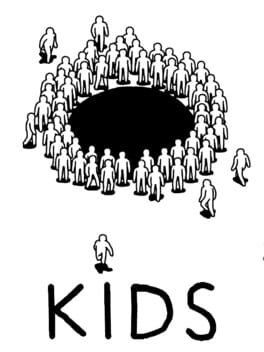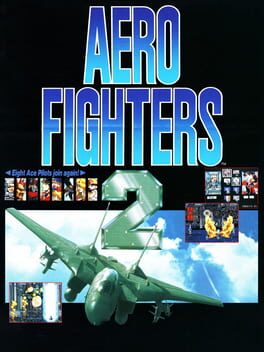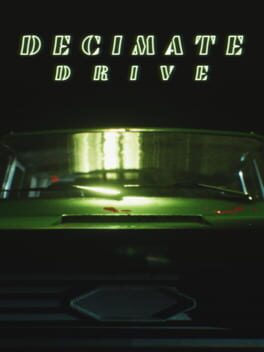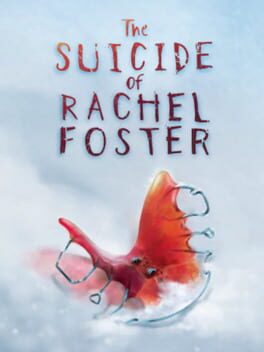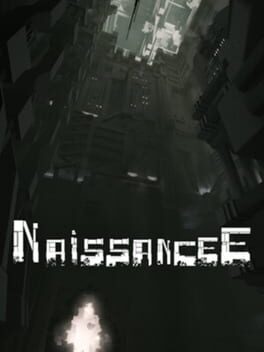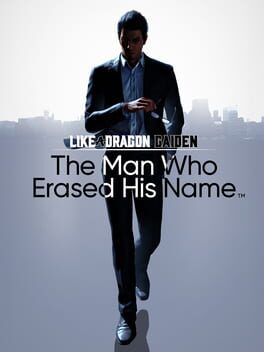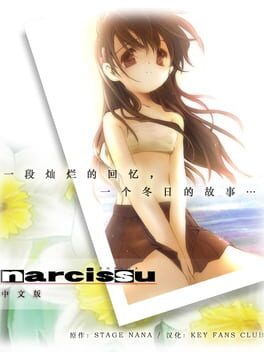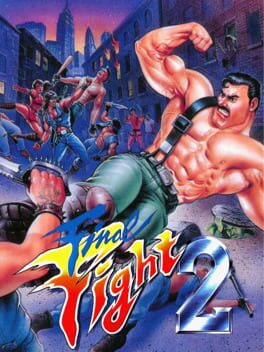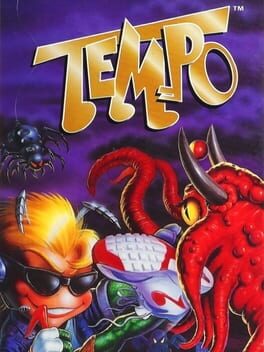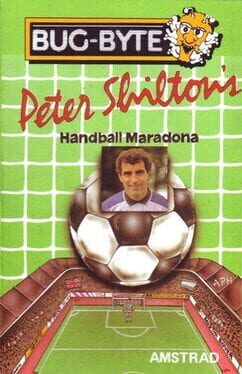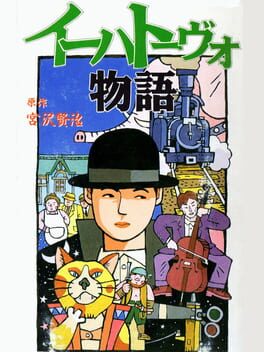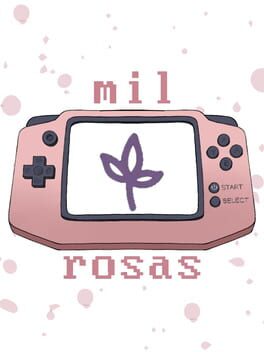Blowing_Wind
239 Reviews liked by Blowing_Wind
Kids
2019
Is this a relaunch or something? Why does Kids feel like it came out 13 years late? I can imagine this game working if it was from idk 2005, like you're browsing around playing some generic flash games then suddenly you find a random weird artsy game, and you're naturally hooked (something similar as to why Samorost worked in that context). But the thing is Kids came out in 2019, and it has no business being from that year. About the game's message... it's about as deep and subtle as a Steve Cutts short. Nothing to see here.
Aero Fighters 2
1994
It may be a bit premature to say, since I haven’t really thought about it all too much, but out of all of the shmups that I have played and reviewed so far, the original Aero Fighters was definitely one of my favorites that I have covered. It definitely had its fair share of quirks that I wasn’t a fan of, such as how short the stages can be and how the game makes you beat it twice in order to beat it completely, but it had multiple characters to select from, plenty of fun shot types to mess around with across each characters, and enough explosive action to make my brain go brr in excitement, which was all enough for me at the end of the day. And hey, it was enough for plenty of others as well, to the point where it would end up getting a sequel not just for arcades, but also for the Neo Geo systems, to ensure that the series would join the SNK Cinematic Universe, or SNKCU, which is totally a real thing. So after two years went by, we would then get the sequel to the original game in the form of Aero Fighters 2.
Repetition is the name of the game when it comes to most shmups, and if there is anything SNK was good at back in the day, it certainly was repetition. While this hasn’t been the case for all of their titles (from what I know anyway), a lot of SNK’s major releases around this era, especially when it comes to their fighting games, have very little differences between them to make them stand out from each other, so it only makes sense that they welcomed a series like Aero Fighters into their family. What I am trying to say here if you haven’t picked up on it at this point is that Aero Fighters 2 is a very “if it ain’t broke, don’t fix it” title, which in this case is a good thing, because Aero Fighters 2 turned out to be yet another pretty good game, one that doesn’t quite surpass the original game, but one that still manages to be fun and frantic for any shmup enthusiast to enjoy.
The story is, what a shocker, aliens are attacking the world again, and it is up to you and an even bigger cast of even more colorful characters are the only ones who can take them down, which I would say is extremely lazy, but the pretty colors and explosions are distracting me and making me forget about all of that. The graphics are almost identical to the previous game, which I would be a teensy bit upset about, but it is an SNK game after all, so there is no use in complaining at that point, the music is pretty good, having plenty of great tracks to listen to while blowing shit up, even if nothing really stuck with me after the playthrough, and the gameplay/control is also identical to that of the original game, which some people could be tired of at this point, but again, I can’t focus on that because of the pretty explosions.
The game is your typical arcade shmup, where you take control of one of eight different characters in different fighter jets, go through a set of ten different stages through locations around the entire world, and even in the depths of space, shoot the fuck out of everything on screen, even if it isn’t trying to kill you at all because you need them bonus points, gather plenty of different powerups to assist you along the way and gather plenty of money icons to increase your points so you can dominate those other chumps in the high score table, and take on plenty of big, bad, and overly-detailed bosses that are a blast to fight, both figuratively and literally. It has just the right blend of familiarity and adrenaline that can be imprinted into your head and make you not want to stop playing, as it remains really fun, despite how, at the end of the day, not too much has changed from the original game.
To summarize this game as a whole, it is basically just Aero Fighters but with more stuff. Not only are all of the stages, bosses, and obstacles that you find new, but there is also more content as a whole, and more fun quirks added to make it that much more memorable and enjoyable. You can even see that as early as whenever you are selecting which fighter jet that you are going to use to use, as not only is there a greater selection then in the last game, but the pilots themselves also have a lot of personality to them, with some of them consisting of an actual baby, a robot, a ninja, and even a motherfucking DOLPHIN! Seriously, how can you not like that? Not to mention, there are more stages, more weapon types to mess around with, more explosions to be seen, and more fun to be had, so if you have a friend that is also a big shmup person like you, you two can jump in and have a really good time with all that is given to you here.
However, for those of you who aren’t so entranced by the art of bullets making contact with objects and watching them burst in an explosive way, then you will probably not find too much enjoyment out of this game, as it is not only yet another typical arcade shmup, but it also has basically zero changes from the original for the most part. Not only that, but the game doesn’t fix any of the problems that I had with the original, with it still being too short, only around 20 minutes or so, and you still have to play through the game twice in order to get the true ending. This isn’t too much of a big deal, especially since the stages themselves are really short, and not to mention there are these new types of stages that just pour power-ups down your throat like it’s candy, but it still doesn’t warrant a second playthrough just to see the stages again with maybe one or two new bosses. Or maybe it does for you, I dunno, but I’m a real one-and-done guy when it comes to shmups, so this is disturbing my natural flow, and I hate it.
Overall, despite its lack of change and its refusal to fix any of the issues I had with it from last time, Aero Fighters 2 manages to still be a really good shmup from the mid-90s, one that gives you all the explosive, fast and fun gameplay that you expect from this series, and one that is just baaaaaaaaaarely better then the original, by a small margin. I would definitely recommend it for those of you who were fans of the original game, as well as those who are shmup fanatics in general, because while you may be short changed of new content, you certainly won’t be short changed of that good ol’ fashioned arcade fun. Again, I have to ask, how can you hate a game where you fight a giant space monkey as a boss? Not only that, but they even one-up themselves here by having a giant eyeball with human hands, and a… weirdly anime-esque octopus boss………….. Japan is weird.
Game #544
Repetition is the name of the game when it comes to most shmups, and if there is anything SNK was good at back in the day, it certainly was repetition. While this hasn’t been the case for all of their titles (from what I know anyway), a lot of SNK’s major releases around this era, especially when it comes to their fighting games, have very little differences between them to make them stand out from each other, so it only makes sense that they welcomed a series like Aero Fighters into their family. What I am trying to say here if you haven’t picked up on it at this point is that Aero Fighters 2 is a very “if it ain’t broke, don’t fix it” title, which in this case is a good thing, because Aero Fighters 2 turned out to be yet another pretty good game, one that doesn’t quite surpass the original game, but one that still manages to be fun and frantic for any shmup enthusiast to enjoy.
The story is, what a shocker, aliens are attacking the world again, and it is up to you and an even bigger cast of even more colorful characters are the only ones who can take them down, which I would say is extremely lazy, but the pretty colors and explosions are distracting me and making me forget about all of that. The graphics are almost identical to the previous game, which I would be a teensy bit upset about, but it is an SNK game after all, so there is no use in complaining at that point, the music is pretty good, having plenty of great tracks to listen to while blowing shit up, even if nothing really stuck with me after the playthrough, and the gameplay/control is also identical to that of the original game, which some people could be tired of at this point, but again, I can’t focus on that because of the pretty explosions.
The game is your typical arcade shmup, where you take control of one of eight different characters in different fighter jets, go through a set of ten different stages through locations around the entire world, and even in the depths of space, shoot the fuck out of everything on screen, even if it isn’t trying to kill you at all because you need them bonus points, gather plenty of different powerups to assist you along the way and gather plenty of money icons to increase your points so you can dominate those other chumps in the high score table, and take on plenty of big, bad, and overly-detailed bosses that are a blast to fight, both figuratively and literally. It has just the right blend of familiarity and adrenaline that can be imprinted into your head and make you not want to stop playing, as it remains really fun, despite how, at the end of the day, not too much has changed from the original game.
To summarize this game as a whole, it is basically just Aero Fighters but with more stuff. Not only are all of the stages, bosses, and obstacles that you find new, but there is also more content as a whole, and more fun quirks added to make it that much more memorable and enjoyable. You can even see that as early as whenever you are selecting which fighter jet that you are going to use to use, as not only is there a greater selection then in the last game, but the pilots themselves also have a lot of personality to them, with some of them consisting of an actual baby, a robot, a ninja, and even a motherfucking DOLPHIN! Seriously, how can you not like that? Not to mention, there are more stages, more weapon types to mess around with, more explosions to be seen, and more fun to be had, so if you have a friend that is also a big shmup person like you, you two can jump in and have a really good time with all that is given to you here.
However, for those of you who aren’t so entranced by the art of bullets making contact with objects and watching them burst in an explosive way, then you will probably not find too much enjoyment out of this game, as it is not only yet another typical arcade shmup, but it also has basically zero changes from the original for the most part. Not only that, but the game doesn’t fix any of the problems that I had with the original, with it still being too short, only around 20 minutes or so, and you still have to play through the game twice in order to get the true ending. This isn’t too much of a big deal, especially since the stages themselves are really short, and not to mention there are these new types of stages that just pour power-ups down your throat like it’s candy, but it still doesn’t warrant a second playthrough just to see the stages again with maybe one or two new bosses. Or maybe it does for you, I dunno, but I’m a real one-and-done guy when it comes to shmups, so this is disturbing my natural flow, and I hate it.
Overall, despite its lack of change and its refusal to fix any of the issues I had with it from last time, Aero Fighters 2 manages to still be a really good shmup from the mid-90s, one that gives you all the explosive, fast and fun gameplay that you expect from this series, and one that is just baaaaaaaaaarely better then the original, by a small margin. I would definitely recommend it for those of you who were fans of the original game, as well as those who are shmup fanatics in general, because while you may be short changed of new content, you certainly won’t be short changed of that good ol’ fashioned arcade fun. Again, I have to ask, how can you hate a game where you fight a giant space monkey as a boss? Not only that, but they even one-up themselves here by having a giant eyeball with human hands, and a… weirdly anime-esque octopus boss………….. Japan is weird.
Game #544
Decimate Drive
2023
If you can get behind the idea of a horror game about cars trying to kill you, then this is actually pretty good.
It's very short, but manages to be anxiety inducing for most of the run time. I always got an inexplicable intense feeling of terror from people chasing me (even if it's not threateningly), and that's what this game felt like, although this time it's an unstoppable metal thing trying to murder you. The concept is silly, but there's enough self awareness humor to appreciate, like the cars taunting you by playing loud music or the ice cream truck that plays daisy bell (which holy shit, that got me). Something to note is the devs decision to make the game take place in a snowy setting, I thought that was a clever way of justifying the cars' crazy movement. Apart from some minor clunk, the only negative thing to mention is the story, that to me personally didn't contribute much. But that's not to say it shouldn't be in the game, I just think it could've been done better. Overall a good surprise, go try it if you have an hour free.
It's very short, but manages to be anxiety inducing for most of the run time. I always got an inexplicable intense feeling of terror from people chasing me (even if it's not threateningly), and that's what this game felt like, although this time it's an unstoppable metal thing trying to murder you. The concept is silly, but there's enough self awareness humor to appreciate, like the cars taunting you by playing loud music or the ice cream truck that plays daisy bell (which holy shit, that got me). Something to note is the devs decision to make the game take place in a snowy setting, I thought that was a clever way of justifying the cars' crazy movement. Apart from some minor clunk, the only negative thing to mention is the story, that to me personally didn't contribute much. But that's not to say it shouldn't be in the game, I just think it could've been done better. Overall a good surprise, go try it if you have an hour free.
Fugue in Void
2018
Gross. Even if you excuse the massive problems with this games story, the gameplay (if you can even call it that) is so banal and lazy it’s insane. It struggles to even be a walking simulator. About 50% of the gameplay is walking, with the other 50% being standing doing nothing while overly long dialogue plays out. Sure, you do sometimes get a dialogue option, but it basically always falls into the category of “option a” and “option a, but slightly different”. It makes no impact on anything.
There’s plenty of good videos that can critique this games story better than I ever could, so I’m not going to bother with that. All I’ll say is that the writer had absolutely no idea about the subjects they were attempting to tackle, and also has zero clue how to write an interesting female character.
There’s plenty of good videos that can critique this games story better than I ever could, so I’m not going to bother with that. All I’ll say is that the writer had absolutely no idea about the subjects they were attempting to tackle, and also has zero clue how to write an interesting female character.
NaissanceE
2014
For a god-like all-knowing powerful being, the puzzles it throws at you are a really pitiful attempt at stopping you... Something ludonarrative dissonance something something.
I was enjoying the game whenever it let you explore (specially those sections that give you the illusion of an open world), that's where the dev's world design shines (great atmosphere for what is a minimal style), that's accompanied by some interesting moments of subtle world building or quirky interactions. But sadly ruined by mundane puzzles and clunky platforming sections that take away from the experience. Also, what's the point of the breathing mechanic? You use it for like 10% of the game, and it practically only exists to distract and not let you immerse yourself. Maybe the devs should've stuck to the premise of it being an "artistic experience" and not a game, even though it sounds pretentious as hell in the steam description. Anyway, I don't want to rip too much into this game since it's free, and the most offensive thing it does is being amateurish... Overall, a decent short game. Discovered "BLAME!" thanks to it too, so I'll probably go right ahead and read that.
(Oh, if you have a monitor with an energy saving feature that turns it off whenever the screen is black, turn that off before playing because the game's really dark, and lifting the gamma to max on the settings seemingly doesn't help lol.)
I was enjoying the game whenever it let you explore (specially those sections that give you the illusion of an open world), that's where the dev's world design shines (great atmosphere for what is a minimal style), that's accompanied by some interesting moments of subtle world building or quirky interactions. But sadly ruined by mundane puzzles and clunky platforming sections that take away from the experience. Also, what's the point of the breathing mechanic? You use it for like 10% of the game, and it practically only exists to distract and not let you immerse yourself. Maybe the devs should've stuck to the premise of it being an "artistic experience" and not a game, even though it sounds pretentious as hell in the steam description. Anyway, I don't want to rip too much into this game since it's free, and the most offensive thing it does is being amateurish... Overall, a decent short game. Discovered "BLAME!" thanks to it too, so I'll probably go right ahead and read that.
(Oh, if you have a monitor with an energy saving feature that turns it off whenever the screen is black, turn that off before playing because the game's really dark, and lifting the gamma to max on the settings seemingly doesn't help lol.)
This franchise has been subject to fifteen years of nonstop milking, overwhelming asset reuse, predatory DLC models, and even the leave of its original creator. Somehow, it still manages to remain not only strong but as emotionally, thematically, and mechanically involved as ever. Like a Dragon has always been best when it explores the concept of identity and recognizes the potential for density within its maps, Gaiden specifically excelling at both. The ending also made me cry buckets!
Narcissu
2005
This review contains spoilers
Cuando hablamos de Narcissu nos referimos a una novela visual que tiene todas las bases para ser un drama con el que muy probablemente sacarías una lagrima, trata sobre dos pacientes terminales que buscan un lugar donde morir mientras reflexionan sobre como sienten que sus vidas han sido insignificantes al ver que como personas no pudieron cumplir sus metas y objetivos. Voy a admitir que no suena mal, hay historias similares que han sido de mi agrado y por ende esperaba encontrarme con montones de reflexiones e introspecciones psicológicas que harían valer la pena jugar este juego que ya de por si dura lo mismo que una película. Lamentablemente, parece que el creador decidió tomar las peores decisiones al momento de escribir la historia.
Partamos del hecho de que los personajes son secos en todo lo que presentan. Por un lado, el protagonista no tiene personalidad pues su función es servir para que el espectador pueda auto insertarse y sentir mas cercano el drama presentado, venga que incluso no tiene nombre y en la única foto que se tiene de el ni se le ve la cara.
Por el otro lado, Setsumi, la coprotagonista, solo es caracterizada por su personalidad fría y callada, siendo alguien que el 99% se la pasa melancólica y triste, llegando a ser agotador pues al inicio de cada capítulo recalca exactamente esto mismo. Se que buscaran defender esto diciendo que es entendible que sea así debido al estado en el que se encuentra y aunque en parte esto pueda ser verdad me sigue pareciendo un error ya que el juego pudo mostrar mas facetas del personaje previo a ser una paciente terminal. Esto ultimo incluso pudo haber hecho un buen contraste haciendo que simpatices más con Setsumi y ya de paso balancear mas el tono del juego para que las escenas tristes no te empalaguen. Y si, sé que tiene una secuela que precisamente hace esto que pido pero realmente no pienso tenerla en cuenta pues funge mas como precuela y en todo caso hubiese preferido que el pasado de Setsumi hubiese sido mostrado intercaladamente en la historia principal y no como un juego exclusivamente centrado en eso.
Otra cosa que molesta de la novela visual es como resulta ser bastante simplista y conveniente en cuanto a eventos se refiere. Los personajes se llaman así mismos “fugitivos” e incluso en una parte parece que los estén buscando, pero no sientes nada de tensión debido a que no muestra la perspectiva de los perseguidores o no parece que sean competentes en ello. ¿No habría seguridad en un hospital para que los pacientes no escapen? ¿Un chico puede robar dinero en una casa de apuestas y no ser buscado por las autoridades? ¿Por qué el tipo de la farmacia no los persiguió? Todas estas escenas del chico robando bien pudieron ser omitidas pues el propósito de mostrar lo apenado que se siente el protagonista luego de robar no termina fluyendo debido a que carece de una catarsis final.
He visto a muchos decir que Narcissu toca varios temas, ciertamente de las cosas que mas alaban de la historia, pero no me termina de calar del todo. Verán, pese a que los temas si son presentados nunca son explorados, no son compartidas otras visiones de los temas más allá de lo que Setsumi piensa y opina. Todo es muy mono lateral, por así decirlo. Que en una historia un personaje se la pare repitiendo sobre la depresión y el vacío de la vida no quiere decir que se estén explorando los temas, debe haber un desarrollo y una conclusión amparada por los mismos pues sin esto los temas se sienten artificiales.
Para este punto no he mencionado ni un solo aspecto positivo y muy probablemente se preguntarán si hay algo que legítimamente me haya gustado de esta obra, a lo cual yo respondo “si”.
La música esta bien, ambienta de buena manera las escenas siendo melodías cálidas y melancólicas. El juego no posee sprites de personajes, algo raro en las novelas visuales, usando en su lugar imágenes de paisajes y escenarios buscando que las pocas escenas donde se muestra a Setsumi te lleguen más al ver todo de forma “distante”.
Puedo darle puntos al final pues, pese a no gustarme que el protagonista no tenga una conclusión formalmente hablando, puedo darle puntos al no ocurrir lo que usualmente esperarías de este tipo de historias. No hay conclusión romántica y no ocurre un milagro que sana mágicamente a la coprotagonista. Setsumi muere al final de forma amarga, y aunque no me haga derramar una lagrima, mínimo apreciare la valentía del juego (por decirlo de alguna forma).
Eso es todo lo que puedo decir de Narcissu, no es nada nunca antes visto existiendo obras con una premisa similar y hasta mejor. Si quieren una recomendación mía sobre un título que trate sobre pacientes terminales vean The Bucket List y si quieren un titulo que trate sobre alguien que “quiere acabar con su vida” vean Mar Adentro. No tendrán una linda chica timida, ni tampoco personajes para auto insertarse, pero personalmente encuentro más valor en esas obras que lo presentado en esta novela visual.
Le doy a Narcissu un 2/10.
Partamos del hecho de que los personajes son secos en todo lo que presentan. Por un lado, el protagonista no tiene personalidad pues su función es servir para que el espectador pueda auto insertarse y sentir mas cercano el drama presentado, venga que incluso no tiene nombre y en la única foto que se tiene de el ni se le ve la cara.
Por el otro lado, Setsumi, la coprotagonista, solo es caracterizada por su personalidad fría y callada, siendo alguien que el 99% se la pasa melancólica y triste, llegando a ser agotador pues al inicio de cada capítulo recalca exactamente esto mismo. Se que buscaran defender esto diciendo que es entendible que sea así debido al estado en el que se encuentra y aunque en parte esto pueda ser verdad me sigue pareciendo un error ya que el juego pudo mostrar mas facetas del personaje previo a ser una paciente terminal. Esto ultimo incluso pudo haber hecho un buen contraste haciendo que simpatices más con Setsumi y ya de paso balancear mas el tono del juego para que las escenas tristes no te empalaguen. Y si, sé que tiene una secuela que precisamente hace esto que pido pero realmente no pienso tenerla en cuenta pues funge mas como precuela y en todo caso hubiese preferido que el pasado de Setsumi hubiese sido mostrado intercaladamente en la historia principal y no como un juego exclusivamente centrado en eso.
Otra cosa que molesta de la novela visual es como resulta ser bastante simplista y conveniente en cuanto a eventos se refiere. Los personajes se llaman así mismos “fugitivos” e incluso en una parte parece que los estén buscando, pero no sientes nada de tensión debido a que no muestra la perspectiva de los perseguidores o no parece que sean competentes en ello. ¿No habría seguridad en un hospital para que los pacientes no escapen? ¿Un chico puede robar dinero en una casa de apuestas y no ser buscado por las autoridades? ¿Por qué el tipo de la farmacia no los persiguió? Todas estas escenas del chico robando bien pudieron ser omitidas pues el propósito de mostrar lo apenado que se siente el protagonista luego de robar no termina fluyendo debido a que carece de una catarsis final.
He visto a muchos decir que Narcissu toca varios temas, ciertamente de las cosas que mas alaban de la historia, pero no me termina de calar del todo. Verán, pese a que los temas si son presentados nunca son explorados, no son compartidas otras visiones de los temas más allá de lo que Setsumi piensa y opina. Todo es muy mono lateral, por así decirlo. Que en una historia un personaje se la pare repitiendo sobre la depresión y el vacío de la vida no quiere decir que se estén explorando los temas, debe haber un desarrollo y una conclusión amparada por los mismos pues sin esto los temas se sienten artificiales.
Para este punto no he mencionado ni un solo aspecto positivo y muy probablemente se preguntarán si hay algo que legítimamente me haya gustado de esta obra, a lo cual yo respondo “si”.
La música esta bien, ambienta de buena manera las escenas siendo melodías cálidas y melancólicas. El juego no posee sprites de personajes, algo raro en las novelas visuales, usando en su lugar imágenes de paisajes y escenarios buscando que las pocas escenas donde se muestra a Setsumi te lleguen más al ver todo de forma “distante”.
Puedo darle puntos al final pues, pese a no gustarme que el protagonista no tenga una conclusión formalmente hablando, puedo darle puntos al no ocurrir lo que usualmente esperarías de este tipo de historias. No hay conclusión romántica y no ocurre un milagro que sana mágicamente a la coprotagonista. Setsumi muere al final de forma amarga, y aunque no me haga derramar una lagrima, mínimo apreciare la valentía del juego (por decirlo de alguna forma).
Eso es todo lo que puedo decir de Narcissu, no es nada nunca antes visto existiendo obras con una premisa similar y hasta mejor. Si quieren una recomendación mía sobre un título que trate sobre pacientes terminales vean The Bucket List y si quieren un titulo que trate sobre alguien que “quiere acabar con su vida” vean Mar Adentro. No tendrán una linda chica timida, ni tampoco personajes para auto insertarse, pero personalmente encuentro más valor en esas obras que lo presentado en esta novela visual.
Le doy a Narcissu un 2/10.
Final Fight 2
1993
everyone even the least bit inquisitive about beat 'em ups as a genre should play this, full stop. i cannot think of a more textbook representation of the idea that for a beat 'em up, encounter design is level design; divergence from this principle in final fight 2 results in perhaps the most anemic beat em up i have ever been subjected to. absolutely lifeless brawling in overlong stages as you contend with wall-to-wall waves of three polite barely dissimilar crooks at a time. devoid of any spirit even compared to some of its home console contemporaries. sure FF2 has a couple of things going for it compared to its predecessor but streets of rage 1 came out two years before this and while it is comparably centered around simplistic crowd control, it thoroughly overpowers this game on the basis of its encounter design, aesthetics, soundtrack, pace, etc. shout outs yuzo koshiro. FF2 does have maki though so who can say whether it's bad or not. bring her back in SF6 capcom i'll be very grateful
Tempo
1995
Silent Hill
1999
Ihatovo Monogatari
1993
Mil Rosas
2021
Song Accompaniment
mil rosas (2021) is an autofiction about Gaby fighting cancer while her family pop in and out to offer words of support. Meanwhile she is playing through as one of the sisters put a 'very boring' fetchquest part of an RPG game on her GBA. The player is tasked with completing this fetchquest while the family pops in to say hi at triggered points in the journey basically interrupting the 'action' of walking and talking with visual novel esque dialogue the that you have to look up from the screen and nod about.
I put emphasis on explaining this because it is to my mind a completely unique set up for a more narrative driven 'story within a story' video play, its worth checking out for that reason alone. I also think given the story is touching on an aspect of disability and illness that is actually ignored, that being a marked lack of mobility and desire to locomote regardless. This double narrative works immensely well and conveying the sense of stasis and isolation that accompanies such a struggle.
The play doesn't settle with just stopping here though. It does something a bit bold and shreds away the conventions of proper names attached to any of the speaking characters whether in the GBA or the IRL characters. This obviously marks as a form of confusion for the player, but it also forces them to pick up the IRL story through context clues. After all we don't walk around outside of work with name badges attached to us so it makes sense not to do so. Along with this the action button, usually used to pull all of the text on screen, here it just skips to the next line instead. So you have to wait for all of it to scroll on screen before hitting the action button. These two factors work in tandem to 'slow down' the normal pace of play, it also makes narrative sense the couple times you make this mistake because one of the psychological effects of chemotherapy is fogginess so it makes sense you would mess up. This whole mediation on health and family works phenomenally well.
My favorite factor that the narrative so elegantly teases at is the idea that handheld consoles have a specific unique quality in their focal experience that elevates them as anxiety suppression devices. A lot of us are used to the concept of sitting down and playing a video game on giant monitors or huge pieces of hardware. This is all fine and well, but it can shred away the appeal of having something in between your hands to mess around with on a trip or as a way to relax between social moments. Handhelds perform a similar function that light novels and magazines do. One of the earliest Nintendo success stories that caused them to pivot was the Game and Watch series which was literally a cheap digital clock with a bit of arcade gameplay for business men to pass the time on the train. The technology has expanded many times over since then allowing for more complex actions and narratives, that's the value mil rosas touches on. The imagined town and delivery situation is a bit more broody than people might initially expect from a top down GBA game, but I really like that idea of a serious and slightly gothic hand held adventure. To this effect how occasionally sassy and poetic the GBA dialogue is works for me, and makes me yearn to play these sorts of hand held titles over the more breezy titles associated with it. My guess is that this distinction in style is due in part to the spanish cultural background. There's rose beads and, going off the name of the work, it was written primarily with a spanish culture and background in mind. So that's likely where the gothic flair is coming from, which I can appreciate.
There are some thorns to this flower though. I mentioned earlier that I liked the dialogue design but I have some caveats: The fact that it functions equally in both the game and IRL the same seems awkward to me. For one I think the GBA characters having names when they talk would have made sense since that's a notable convention worth some parody on. More specifically though the pace and function of both dialogues operating and scrolling the same reveals an issue of narrative monotony. These two realms should operate distinctively because the whole point is that the Handheld is a form of escape. On top of this, the rather dreadful song adds a lot to the piece but doesn't change or stop when you enter or exit a room. Real missed opportunity for immersion here. That being said an argument could be made that the music is not actually playing from within the GBA, that its just an auditory hallucination or non diagetic accompaniment. If this is the case, it does improve the sense of monotony and dread but even here I think it should have lightened up or changed as the story went along from the initial sense of disorientation since its indicated within the plot much the same idea.
With that said this is a really unique and profound reflection far worth giving a shot. Especially in terms of the spatial nostalgia during illness makes it absolutely worth giving a try!
P.S. I recognize that assessing the 'value' and formal reflection on an autofiction may come off as rude or meanspirited. I notice that a lot of people get too shy when talking about the formal qualities of a 'personal' work. I think this can do a disservice to the art form though. Almost all poems are about grief, trauma, or personal love but we take no mind in analyzing poetry and form. Poets usually don't get hostile against poetic analysis of their very personal poems. I think if we really want to develop our minds and engagement with this medium its worth assessing what even the most personal works did and where they may have faltered. In particular the way critics seem to treat criticizing very personal videoplays as if you're battering somebodies brainchild reveals a quite false assumption that art cant be personal if its made by more than a half dozen people. All art has the element of 'personal' in it, and to assume we should hold back our thoughts on assumptions of how personal something is I think misses the point of good criticism in being agnostic to this fact entirely. No I think the reason people jump to this idea that its 'too personal to criticize' is out of a veiled sense of embarrassment of experiencing (and often enjoying) something outside the bounds of what they are 'supposed' to. Stop being so shy then! People love to know about the obscure. Just food for thought.
mil rosas (2021) is an autofiction about Gaby fighting cancer while her family pop in and out to offer words of support. Meanwhile she is playing through as one of the sisters put a 'very boring' fetchquest part of an RPG game on her GBA. The player is tasked with completing this fetchquest while the family pops in to say hi at triggered points in the journey basically interrupting the 'action' of walking and talking with visual novel esque dialogue the that you have to look up from the screen and nod about.
I put emphasis on explaining this because it is to my mind a completely unique set up for a more narrative driven 'story within a story' video play, its worth checking out for that reason alone. I also think given the story is touching on an aspect of disability and illness that is actually ignored, that being a marked lack of mobility and desire to locomote regardless. This double narrative works immensely well and conveying the sense of stasis and isolation that accompanies such a struggle.
The play doesn't settle with just stopping here though. It does something a bit bold and shreds away the conventions of proper names attached to any of the speaking characters whether in the GBA or the IRL characters. This obviously marks as a form of confusion for the player, but it also forces them to pick up the IRL story through context clues. After all we don't walk around outside of work with name badges attached to us so it makes sense not to do so. Along with this the action button, usually used to pull all of the text on screen, here it just skips to the next line instead. So you have to wait for all of it to scroll on screen before hitting the action button. These two factors work in tandem to 'slow down' the normal pace of play, it also makes narrative sense the couple times you make this mistake because one of the psychological effects of chemotherapy is fogginess so it makes sense you would mess up. This whole mediation on health and family works phenomenally well.
My favorite factor that the narrative so elegantly teases at is the idea that handheld consoles have a specific unique quality in their focal experience that elevates them as anxiety suppression devices. A lot of us are used to the concept of sitting down and playing a video game on giant monitors or huge pieces of hardware. This is all fine and well, but it can shred away the appeal of having something in between your hands to mess around with on a trip or as a way to relax between social moments. Handhelds perform a similar function that light novels and magazines do. One of the earliest Nintendo success stories that caused them to pivot was the Game and Watch series which was literally a cheap digital clock with a bit of arcade gameplay for business men to pass the time on the train. The technology has expanded many times over since then allowing for more complex actions and narratives, that's the value mil rosas touches on. The imagined town and delivery situation is a bit more broody than people might initially expect from a top down GBA game, but I really like that idea of a serious and slightly gothic hand held adventure. To this effect how occasionally sassy and poetic the GBA dialogue is works for me, and makes me yearn to play these sorts of hand held titles over the more breezy titles associated with it. My guess is that this distinction in style is due in part to the spanish cultural background. There's rose beads and, going off the name of the work, it was written primarily with a spanish culture and background in mind. So that's likely where the gothic flair is coming from, which I can appreciate.
There are some thorns to this flower though. I mentioned earlier that I liked the dialogue design but I have some caveats: The fact that it functions equally in both the game and IRL the same seems awkward to me. For one I think the GBA characters having names when they talk would have made sense since that's a notable convention worth some parody on. More specifically though the pace and function of both dialogues operating and scrolling the same reveals an issue of narrative monotony. These two realms should operate distinctively because the whole point is that the Handheld is a form of escape. On top of this, the rather dreadful song adds a lot to the piece but doesn't change or stop when you enter or exit a room. Real missed opportunity for immersion here. That being said an argument could be made that the music is not actually playing from within the GBA, that its just an auditory hallucination or non diagetic accompaniment. If this is the case, it does improve the sense of monotony and dread but even here I think it should have lightened up or changed as the story went along from the initial sense of disorientation since its indicated within the plot much the same idea.
With that said this is a really unique and profound reflection far worth giving a shot. Especially in terms of the spatial nostalgia during illness makes it absolutely worth giving a try!
P.S. I recognize that assessing the 'value' and formal reflection on an autofiction may come off as rude or meanspirited. I notice that a lot of people get too shy when talking about the formal qualities of a 'personal' work. I think this can do a disservice to the art form though. Almost all poems are about grief, trauma, or personal love but we take no mind in analyzing poetry and form. Poets usually don't get hostile against poetic analysis of their very personal poems. I think if we really want to develop our minds and engagement with this medium its worth assessing what even the most personal works did and where they may have faltered. In particular the way critics seem to treat criticizing very personal videoplays as if you're battering somebodies brainchild reveals a quite false assumption that art cant be personal if its made by more than a half dozen people. All art has the element of 'personal' in it, and to assume we should hold back our thoughts on assumptions of how personal something is I think misses the point of good criticism in being agnostic to this fact entirely. No I think the reason people jump to this idea that its 'too personal to criticize' is out of a veiled sense of embarrassment of experiencing (and often enjoying) something outside the bounds of what they are 'supposed' to. Stop being so shy then! People love to know about the obscure. Just food for thought.
LSD: Dream Emulator
1998
I honestly don't remember which taught me about video games as an art form first, LSD: Dream Emulator or Shadow of The Colossus... But anyway, I'll always appreciate this game for that, even if I didn't quite understand it at first (I remember a childhood friend in primary school talking about this game and I thought it was dumb hippie stuff, lol).
Coincidentally, I've just played a few dream logic games before this, and they didn't quite grab me. I think what LSD excels at is creating those dynamic unique moments, be it scary, bizarre, or beautiful. I guess those previous game felt a lot more linear... like there's a trail to follow, but at least to me, that's not really how it works in dreams. I mean, just a few days ago I had a dream where I was in Asgard(?), a golden city full of people, then the dream turned into a horror scene where I was being chased by a dark figure in a tunnel, which that figure turned out to be Orlando Bloom in a monster(?) suit. After, I remember an image of a car getting out of control, and I woke up hysterically laughing from that image. Pure nonsense, just like this game. Perfect.
Coincidentally, I've just played a few dream logic games before this, and they didn't quite grab me. I think what LSD excels at is creating those dynamic unique moments, be it scary, bizarre, or beautiful. I guess those previous game felt a lot more linear... like there's a trail to follow, but at least to me, that's not really how it works in dreams. I mean, just a few days ago I had a dream where I was in Asgard(?), a golden city full of people, then the dream turned into a horror scene where I was being chased by a dark figure in a tunnel, which that figure turned out to be Orlando Bloom in a monster(?) suit. After, I remember an image of a car getting out of control, and I woke up hysterically laughing from that image. Pure nonsense, just like this game. Perfect.
